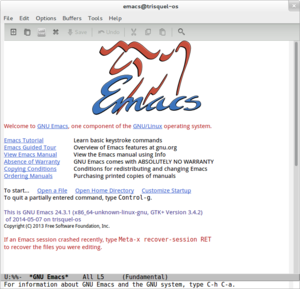GNU Emacs

GNU Emacs 24.3.1 on GNOME 3
|
|
| Original author(s) | Richard Stallman and Guy L. Steele, Jr. |
|---|---|
| Developer(s) | GNU Project |
| Initial release | 20 March 1985 |
| Stable release |
25.1 / 17 September 2016
|
| Preview release |
25.1-RC2 / 22 August 2016
|
| Repository | git |
| Written in | C, Emacs Lisp |
| Operating system | GNU, Linux, Windows, macOS, BSDs |
| Available in | English |
| Type | Text editor |
| License | GNU GPLv3 |
| Website | www |
GNU Emacs is the most popular and most ported Emacs text editor. It was created by GNU Project founder Richard Stallman. In common with other varieties of Emacs, GNU Emacs is extensible using a Turing complete programming language. GNU Emacs has been called "the most powerful text editor available today." With proper support from the underlying system, GNU Emacs is able to display files in multiple character sets, and has been able to simultaneously display most human languages since at least 1999. Throughout its history, GNU Emacs has been a central component of the GNU project, and a flagship of the free software movement. GNU Emacs is sometimes abbreviated as GNUMACS, especially to differentiate it from other EMACS variants. The tag line for GNU Emacs is "the extensible self-documenting text editor".
In 1976, Stallman wrote the first Emacs (“Editor MACroS”), and in 1984, began work on GNU Emacs, to produce a free software alternative to the proprietary Gosling Emacs. GNU Emacs was initially based on Gosling Emacs, but Stallman's replacement of its Mocklisp interpreter with a true Lisp interpreter required that nearly all of its code be rewritten. This became the first program released by the nascent GNU Project. GNU Emacs is written in C and provides Emacs Lisp, also implemented in C, as an extension language. Version 13, the first public release, was made on March 20, 1985. The first widely distributed version of GNU Emacs was version 15.34, released later in 1985. Early versions of GNU Emacs were numbered as "1.x.x," with the initial digit denoting the version of the C core. The "1" was dropped after version 1.12 as it was thought that the major number would never change, and thus the major version skipped from "1" to "13". A new third version number was added to represent changes made by user sites. In the current numbering scheme, a number with two components signifies a release version, with development versions having three components.
GNU Emacs was later ported to Unix. It offered more features than Gosling Emacs, in particular a full-featured Lisp as its extension language, and soon replaced Gosling Emacs as the de facto Unix Emacs editor. Markus Hess exploited a security flaw in GNU Emacs' email subsystem in his 1986 cracking spree, in which he gained superuser access to Unix computers.
...
Wikipedia
